Abstract
1. Changes in regional blood flow and cardiodynamics were measured in anaesthetized paralysed cats during electrical stimulation of the rostral fastigial nucleus.
2. Fastigial stimulation results in a graded, highly reproducible and stereotyped cardiovascular response characterized by (a) increased systolic, diastolic and mean arterial pressures without changes in central venous or occluded vein pressure, (b) decreased blood flow and increased vascular resistance in the axillary, renal, femoral and mesenteric arteries, increased flow without any change in vascular resistance in the common carotid artery, and increase in total peripheral resistance, (c) a small increase in heart rate and myocardial contractile force, decrease in calculated stroke volume, and no change in the cardiac output.
3. Changes in regional arterial flow were abolished by transection of sympathetic nerves or blockade of α-adrenergic receptors by systemic administration of phentolamine.
4. Changes in heart rate and myocardial contractility were abolished by stellate ganglionectomy or blockade of β-adrenergic receptors by propranolol.
5. No changes in pupillary diameter or retraction of the nictitating membrane were seen during fastigial stimulation with stimuli producing substantial changes in blood pressure.
6. The fastigial pressor response represents a highly reproducible, stereotyped, graded, and differentiated pattern of activation of sympathetic preganglionic neurones.
7. The pattern of cardiovascular effects of fastigial stimulation simulates the compensatory (orthostatic) reflex response to maintenance of an upright posture.
8. Fastigial stimulation appears to excite the neural network subserving orthostatic reflexes.
Full text
PDF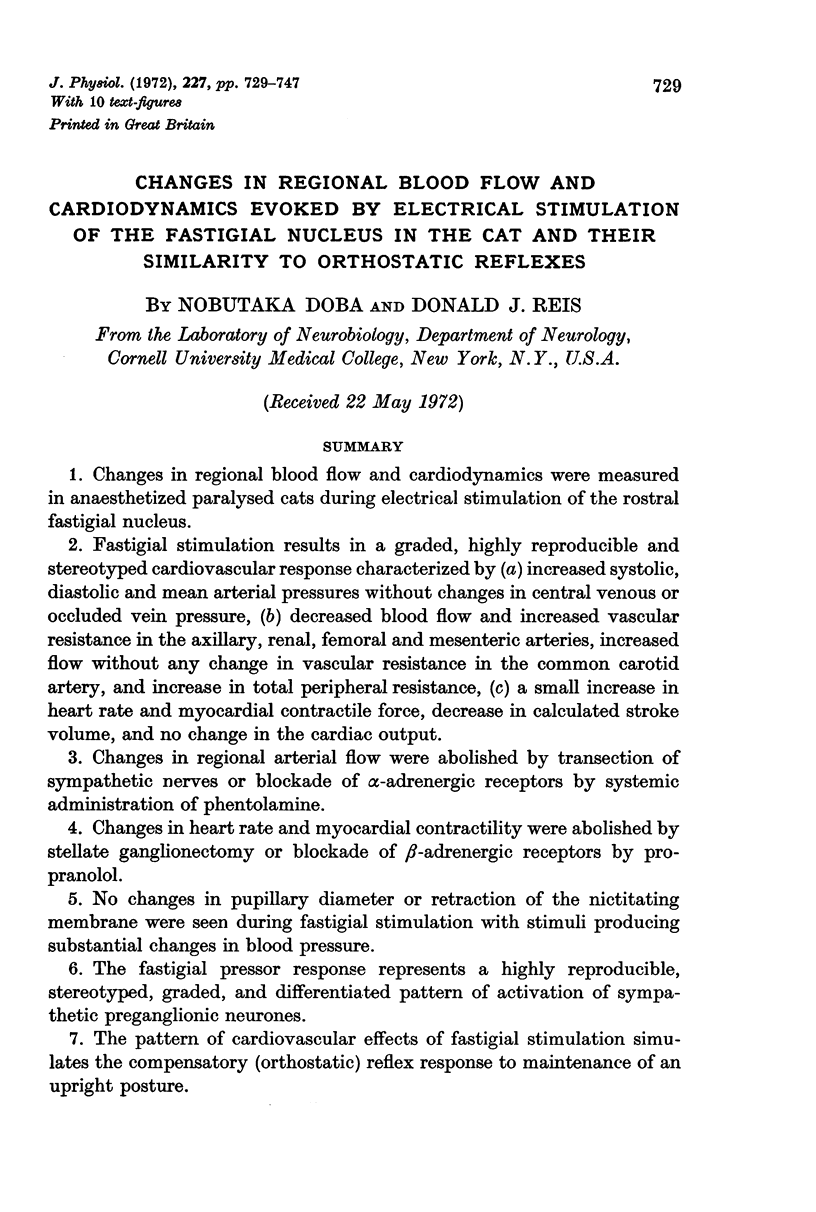
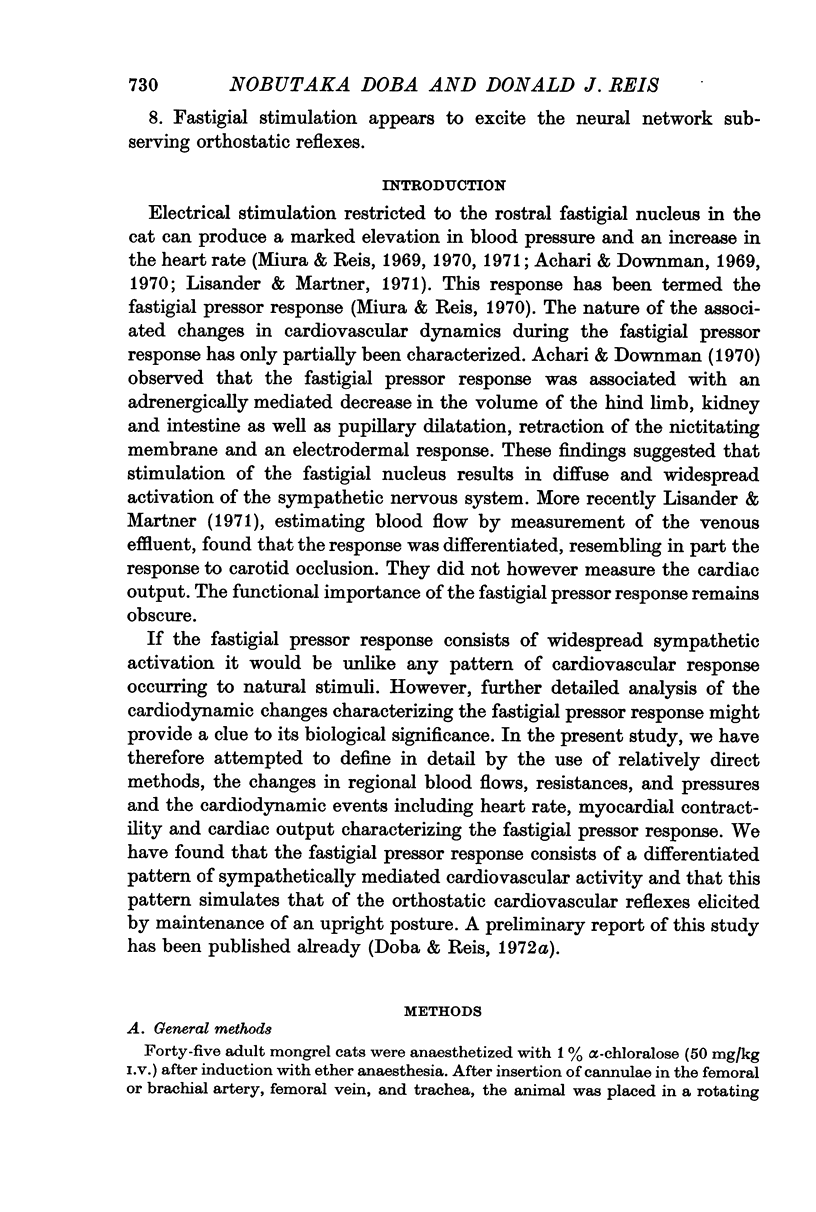
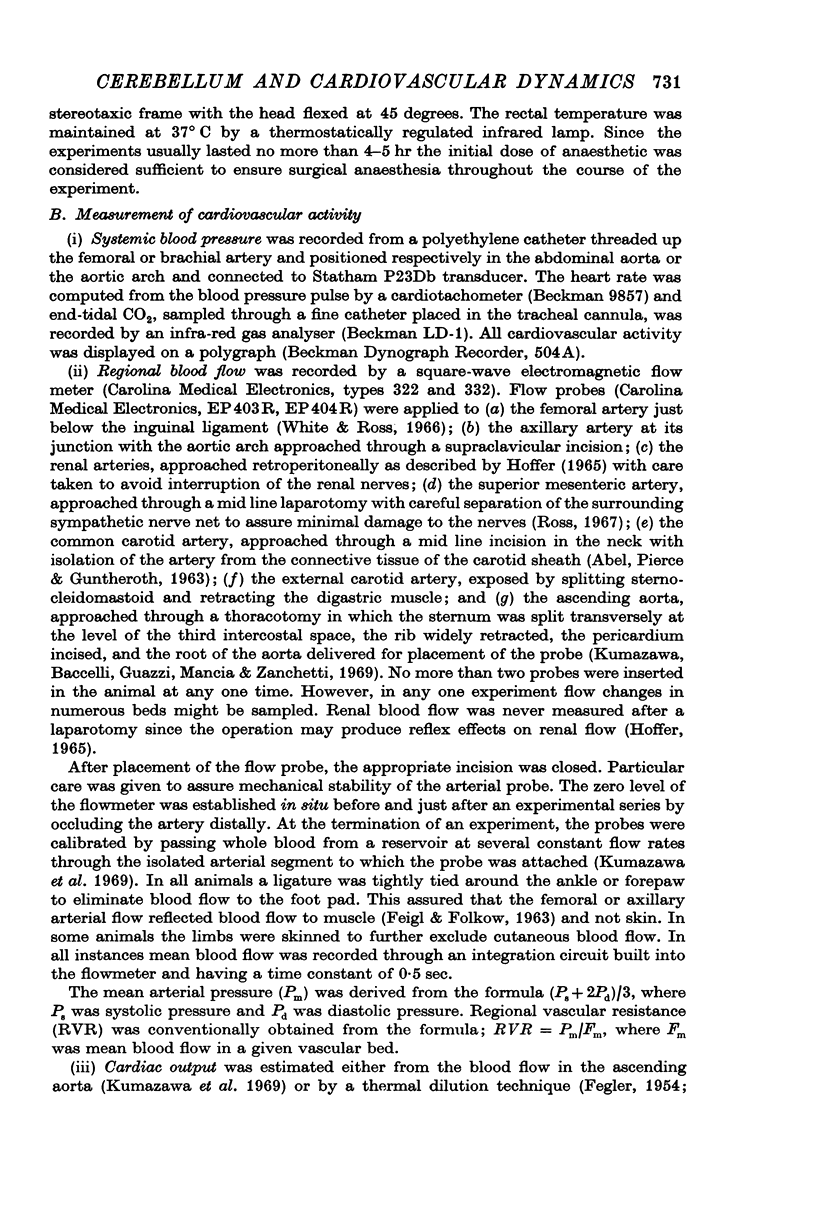
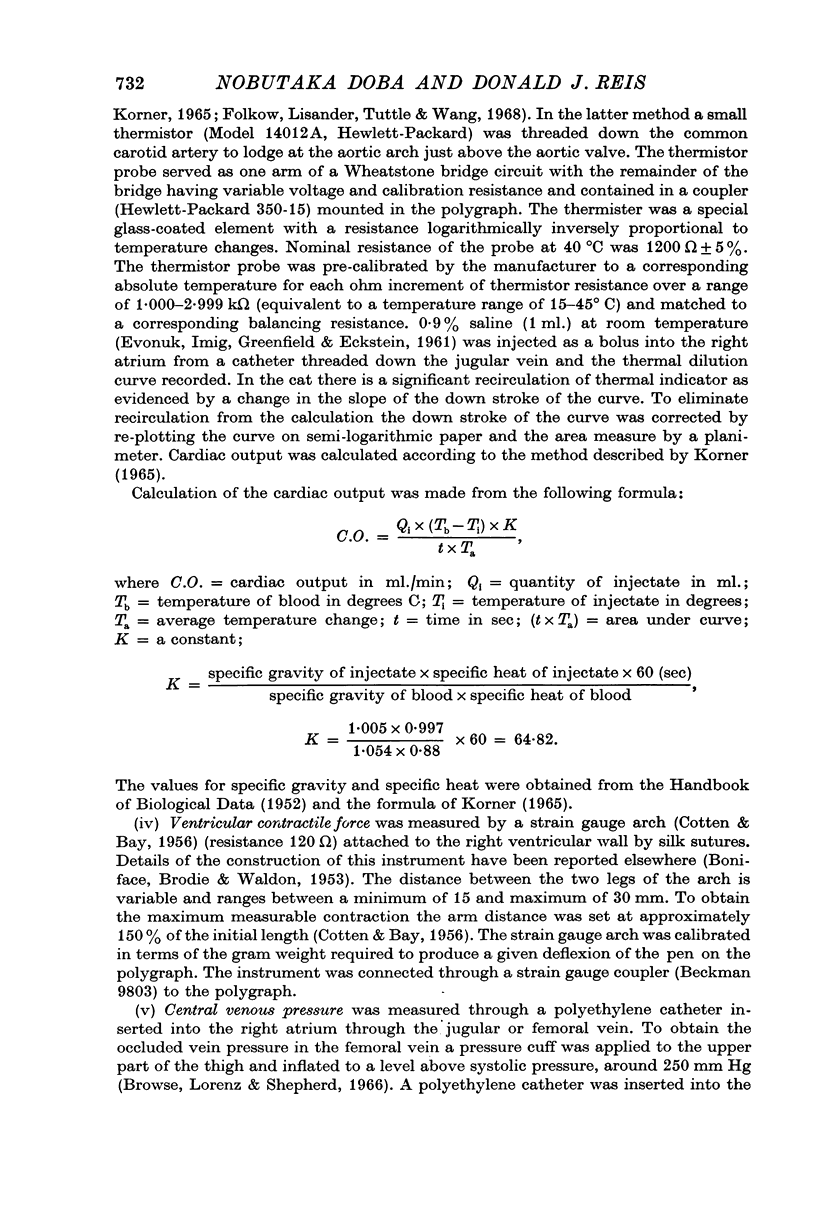


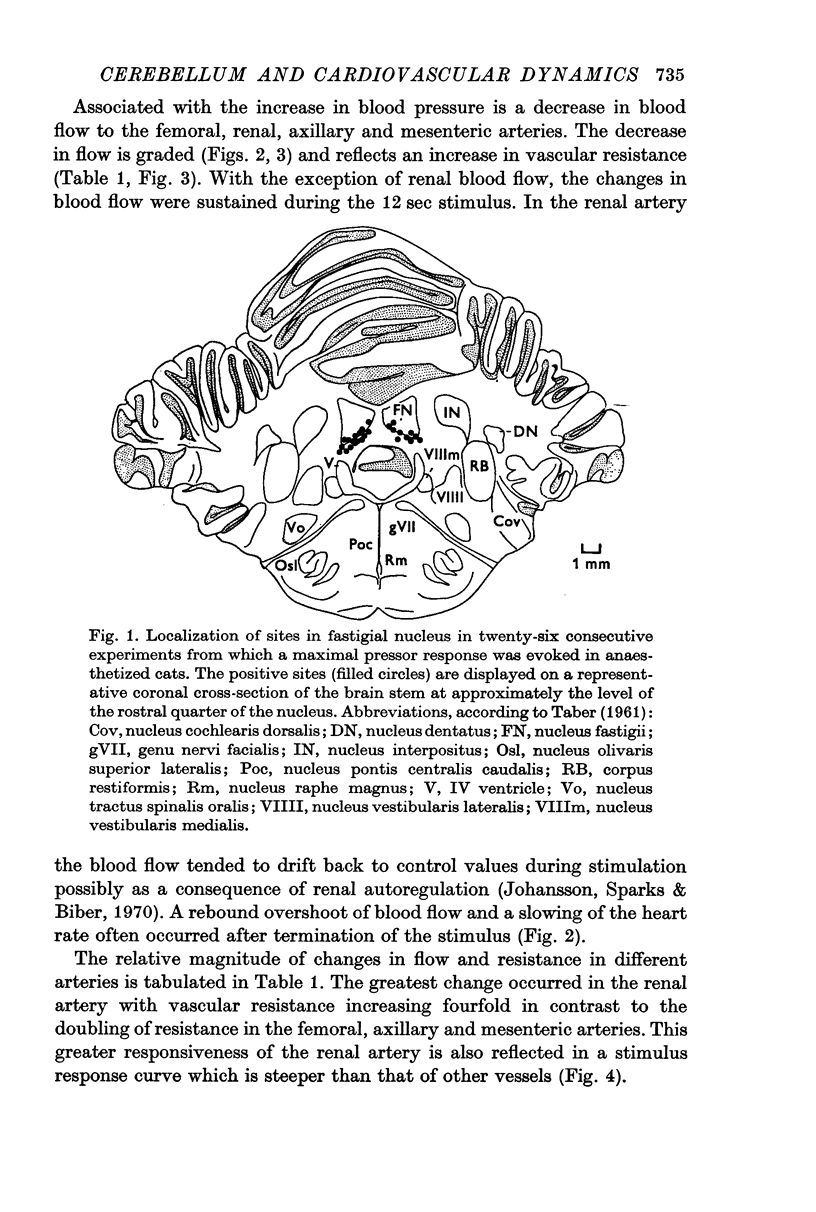
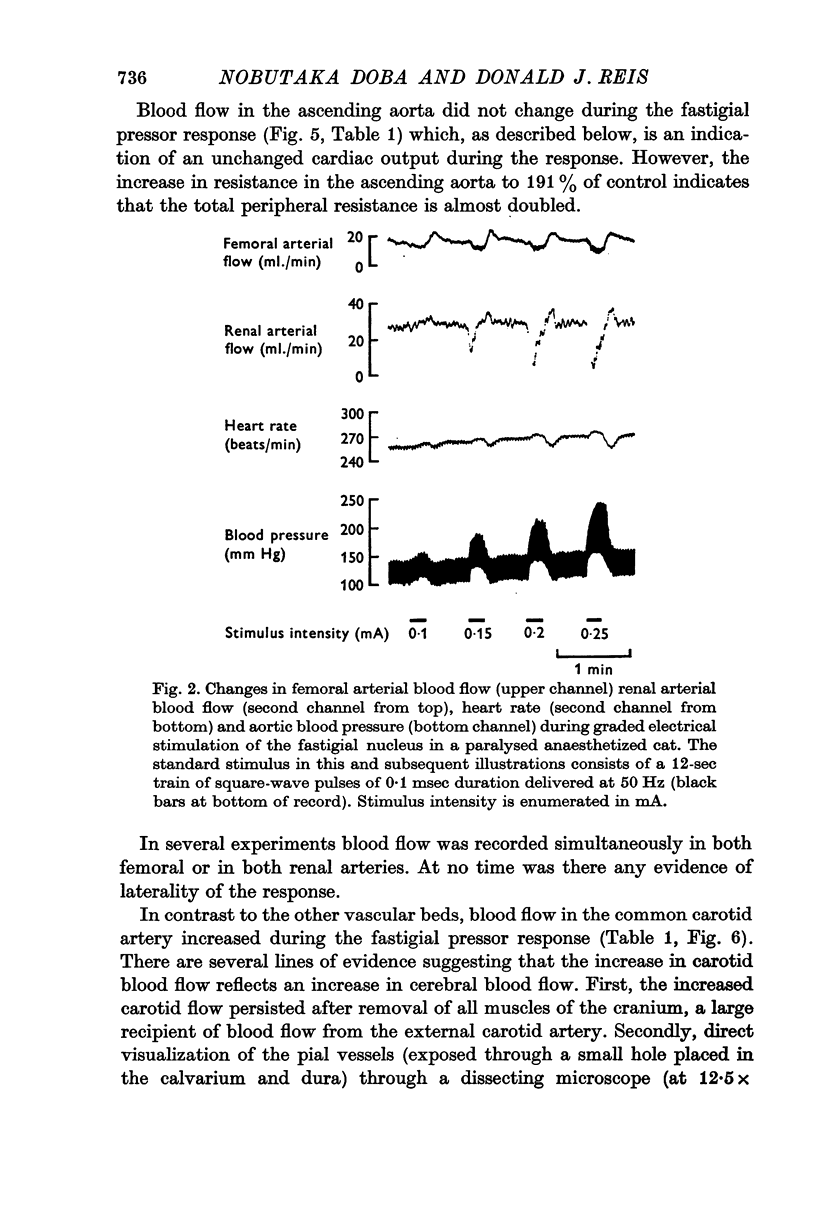
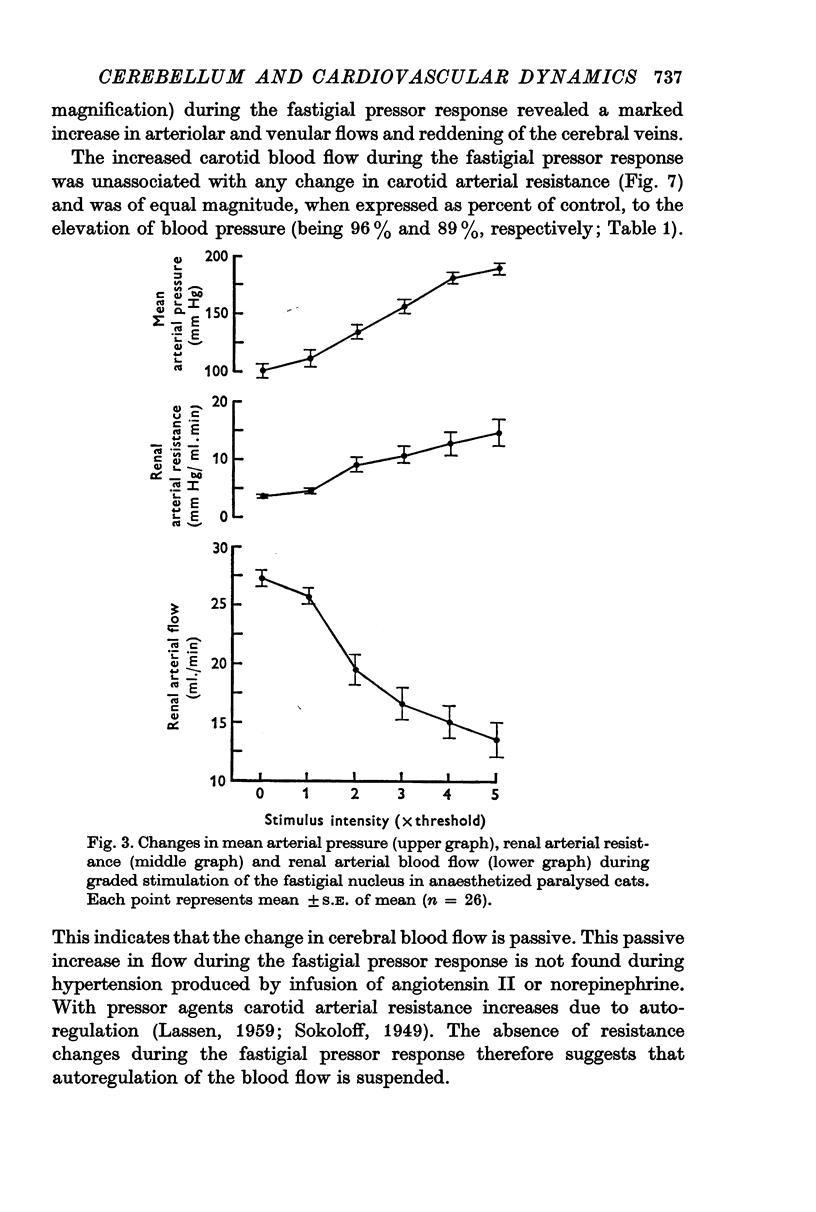
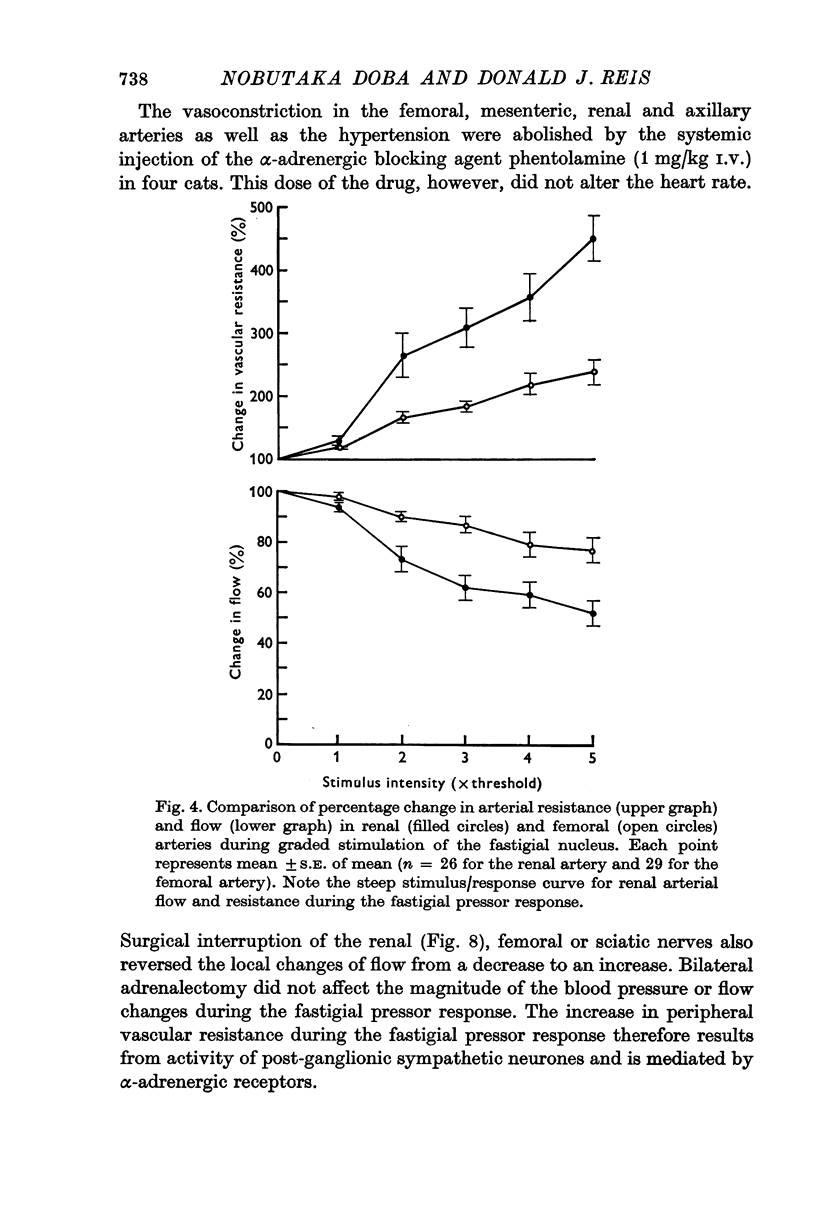
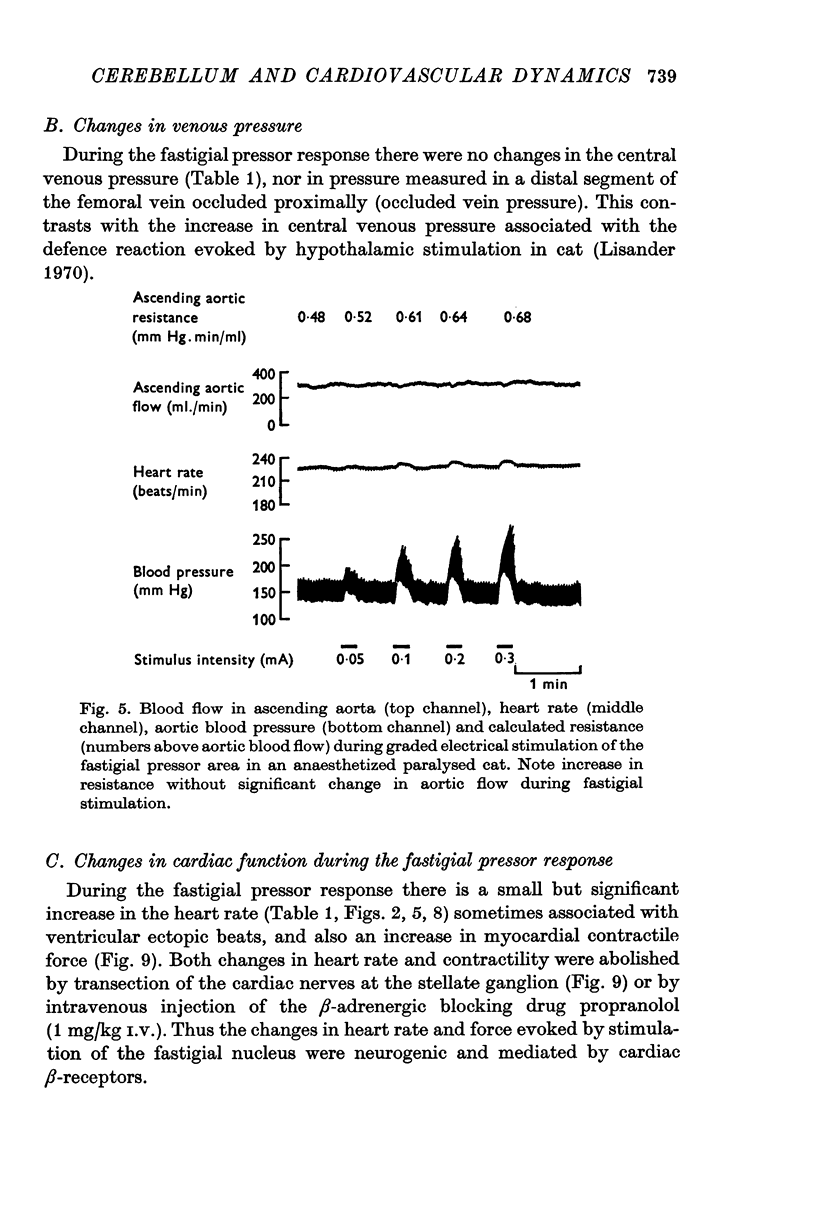
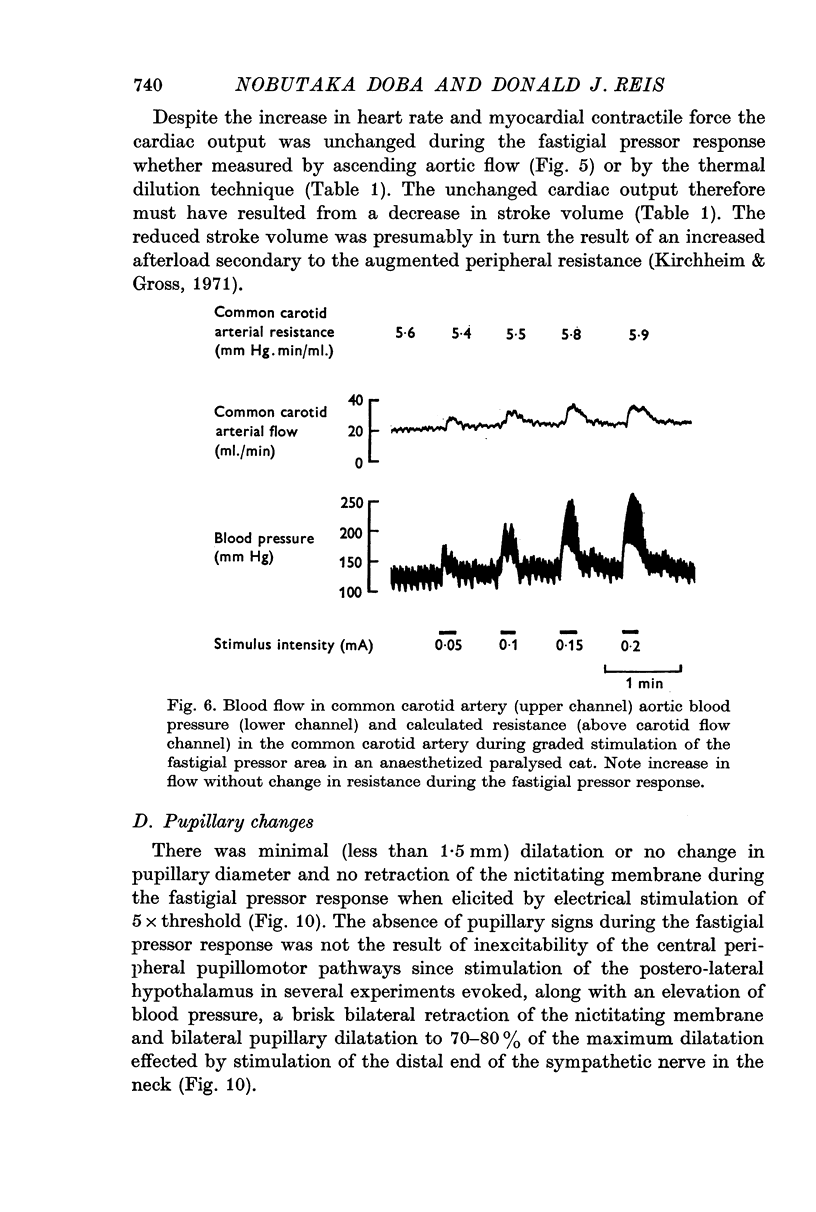
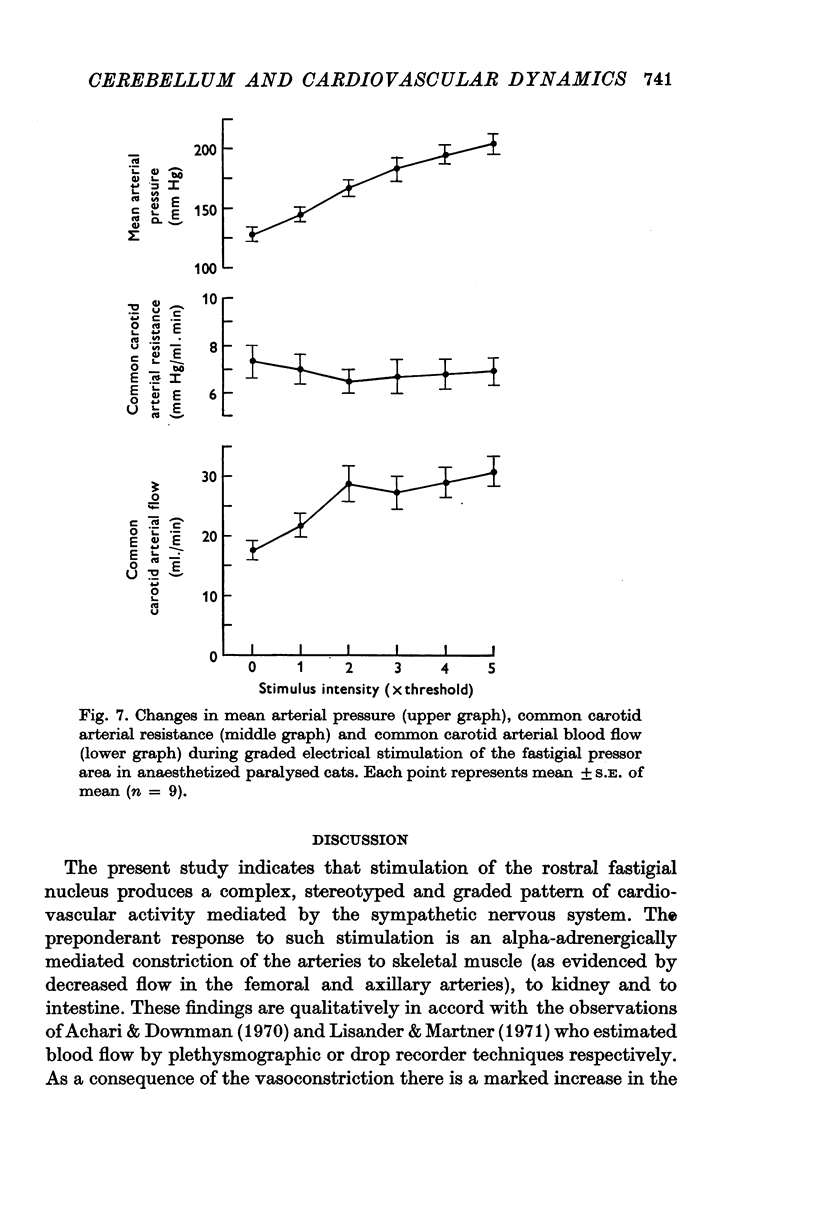
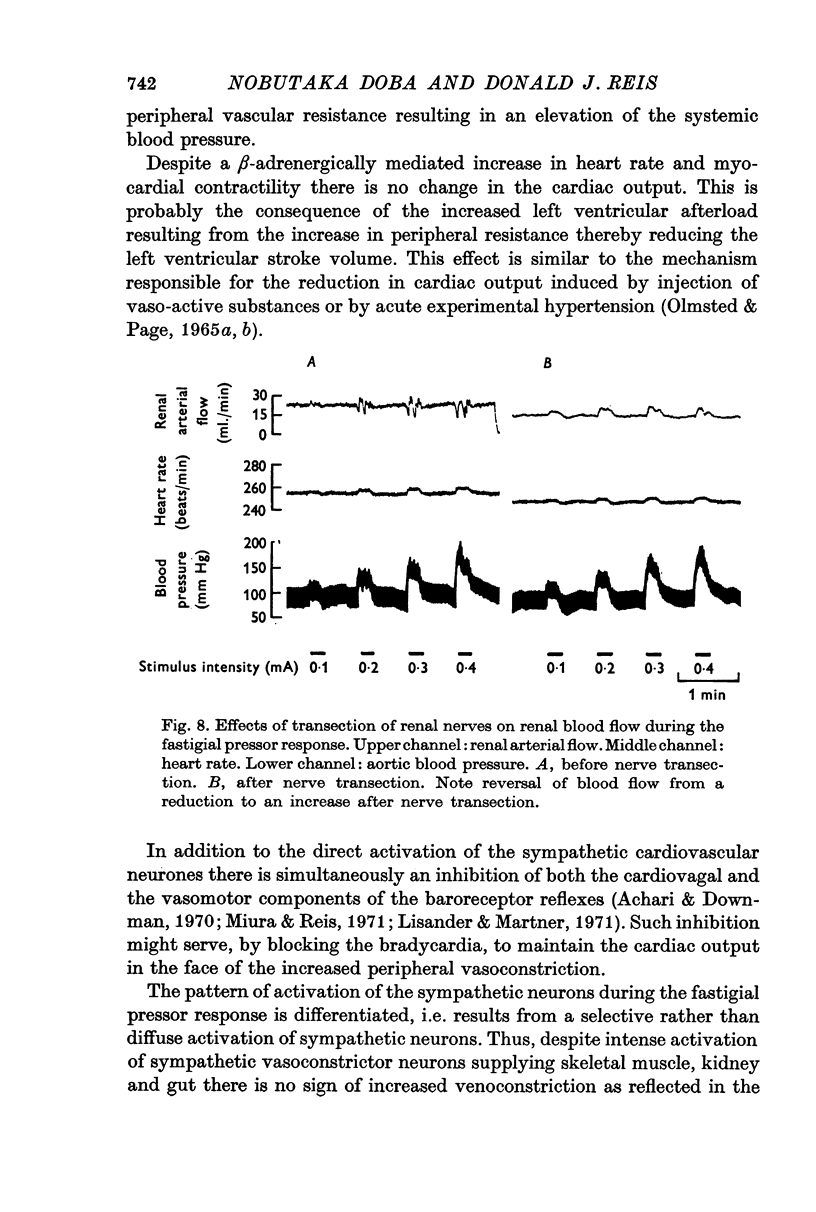
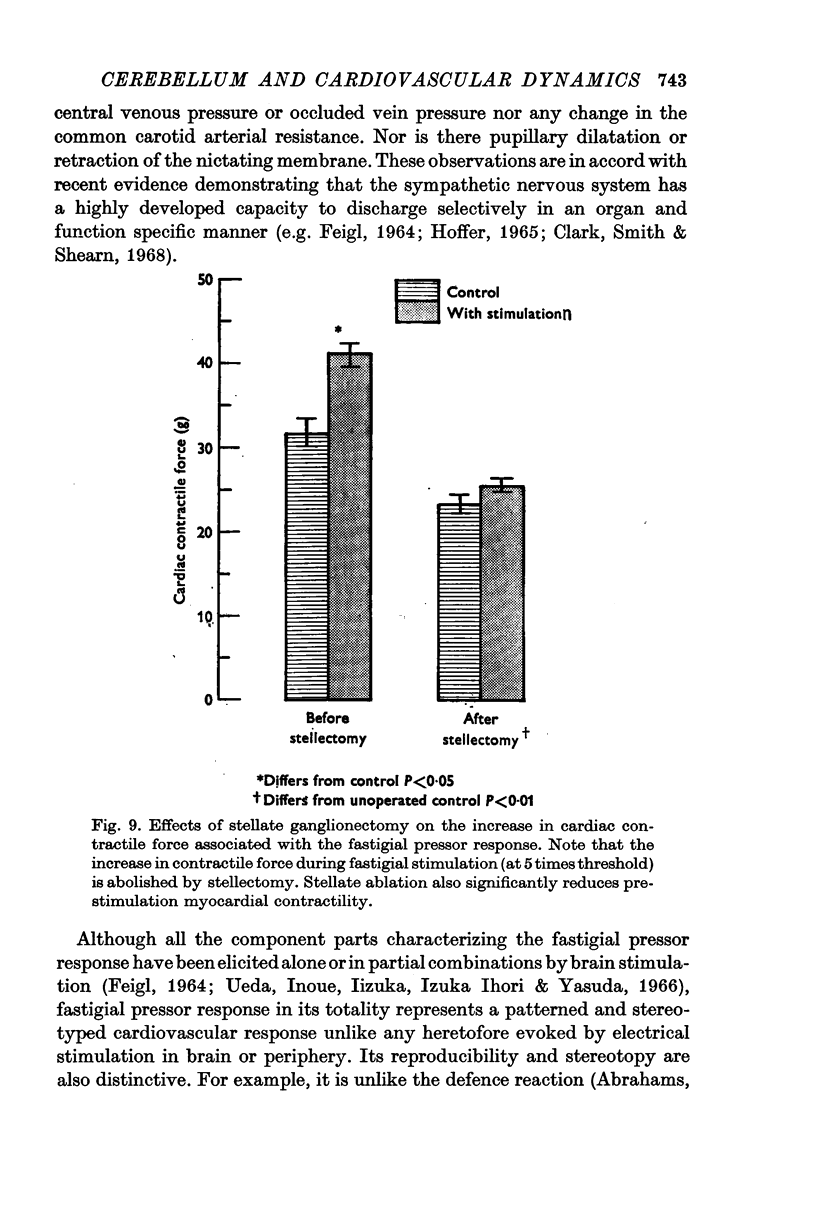
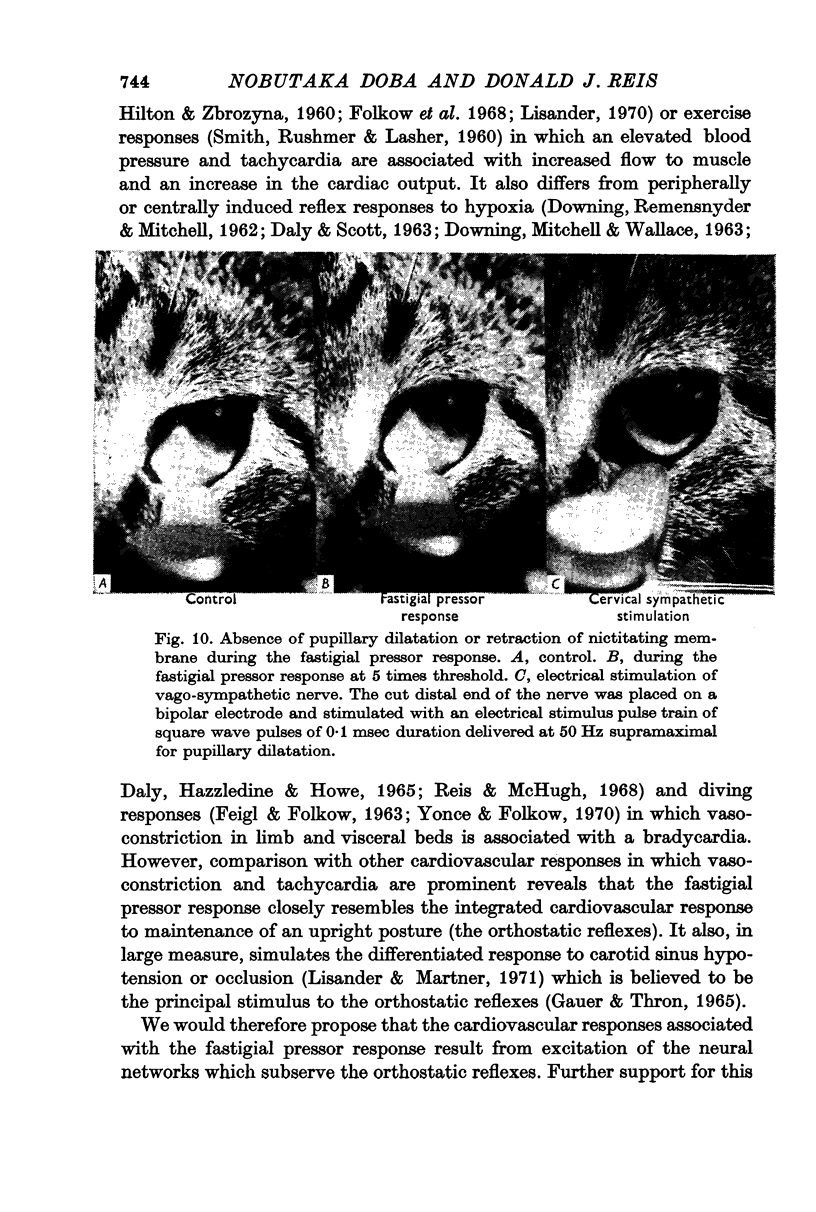
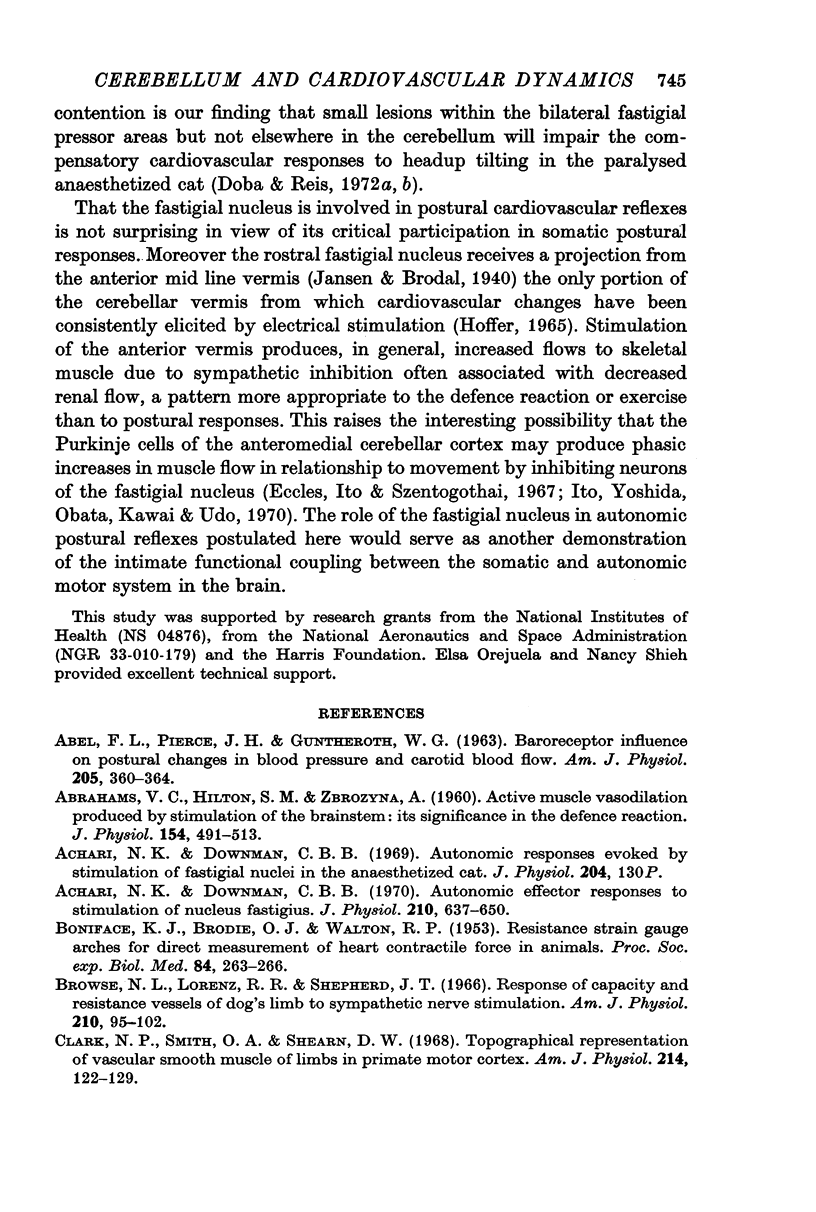
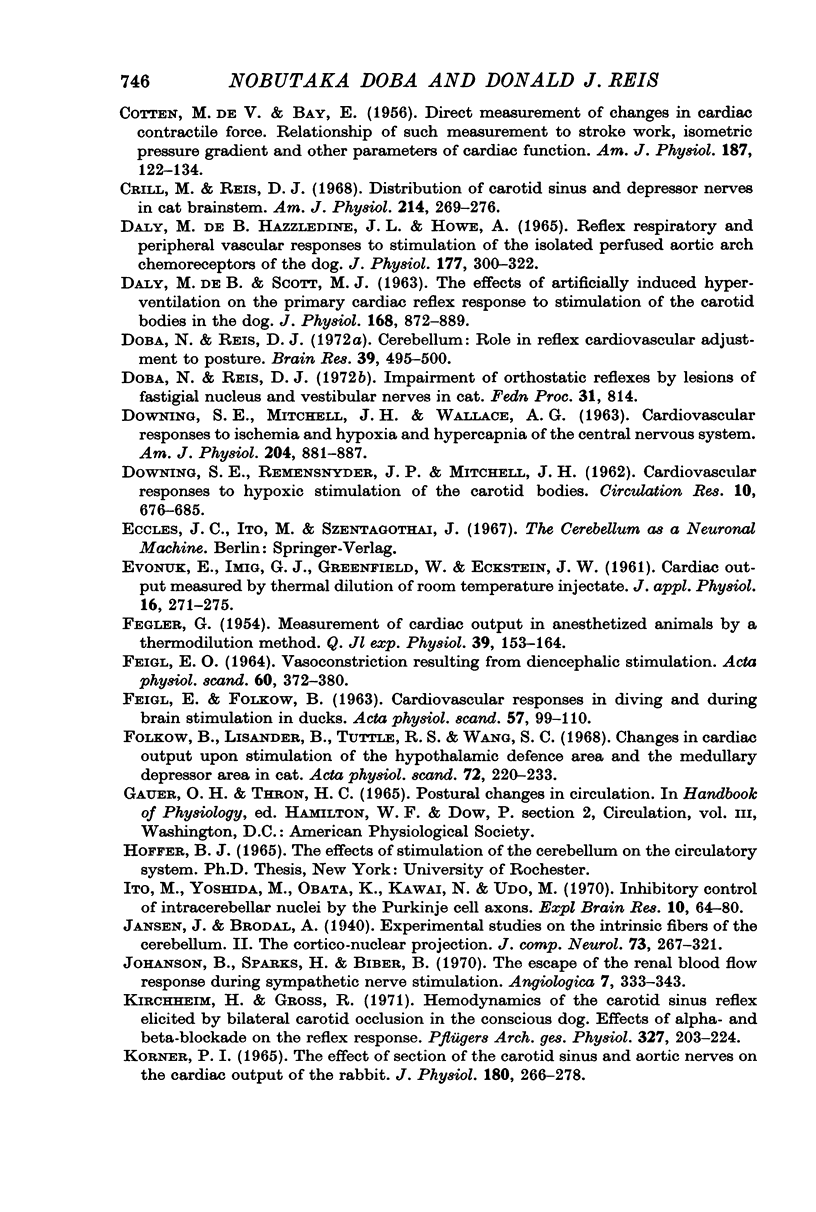
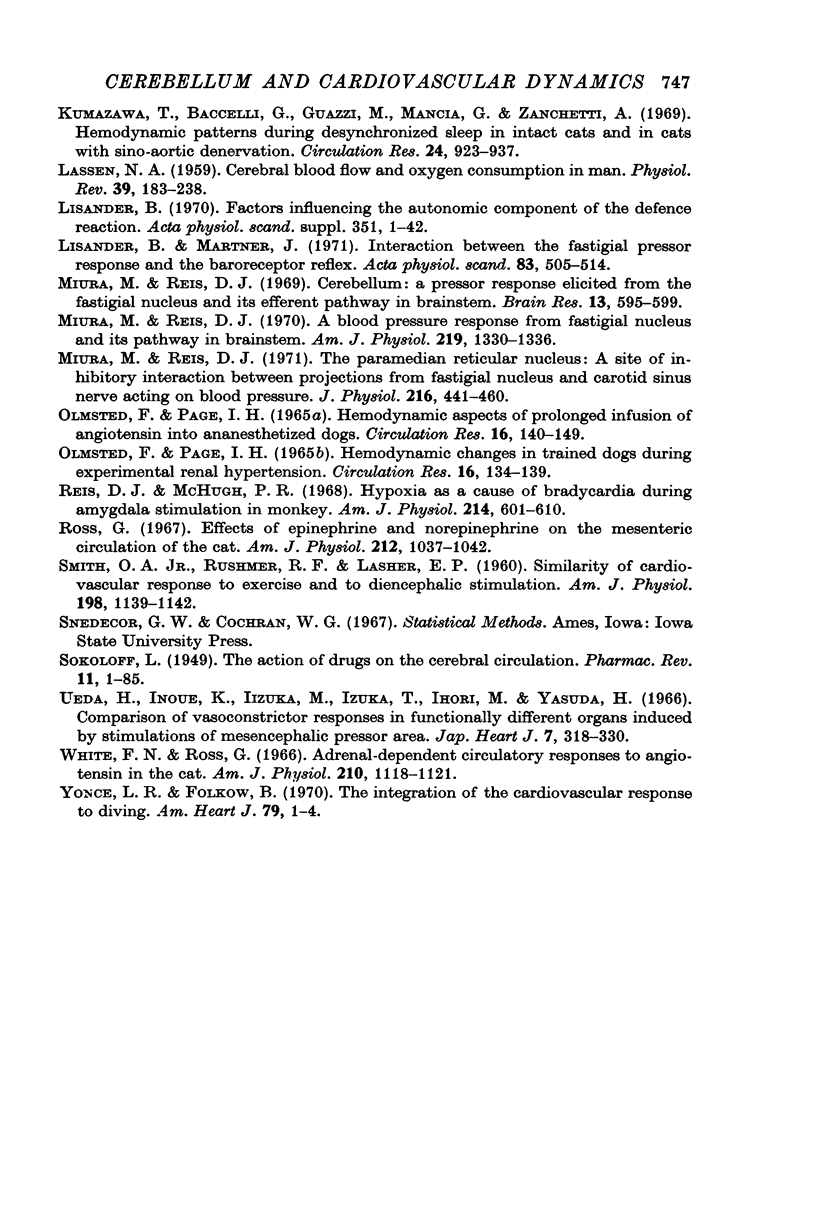
Images in this article
Selected References
These references are in PubMed. This may not be the complete list of references from this article.
- ABEL F. L., PIERCE J. H., GUNTHEROTH W. G. BARORECEPTOR INFLUENCE ON POSTURAL CHANGES IN BLOOD PRESSURE AND CAROTID BLOOD FLOW. Am J Physiol. 1963 Aug;205:360–364. doi: 10.1152/ajplegacy.1963.205.2.360. [DOI] [PubMed] [Google Scholar]
- ABRAHAMS V. C., HILTON S. M., ZBROZYNA A. Active muscle vasodilatation produced by stimulation of the brain stem: its significance in the defence reaction. J Physiol. 1960 Dec;154:491–513. doi: 10.1113/jphysiol.1960.sp006593. [DOI] [PMC free article] [PubMed] [Google Scholar]
- Achari N. K., Downman C. B. Autonomic effector responses to stimulation of nucleus fastigius. J Physiol. 1970 Oct;210(3):637–650. doi: 10.1113/jphysiol.1970.sp009232. [DOI] [PMC free article] [PubMed] [Google Scholar]
- Achari N. K., Downman C. B. Autonomic responses evoked by stimulation of fastigial nuclei in the anaesthetized cat. J Physiol. 1969 Oct;204(2):130P+–130P+. [PubMed] [Google Scholar]
- BAY E., COTTEN M. D. Direct measurement of changes in cardiac contractile force; relationship of such measurements to stroke work, isometric pressure gradient and other parameters of cardiac function. Am J Physiol. 1956 Sep;187(1):122–134. doi: 10.1152/ajplegacy.1956.187.1.122. [DOI] [PubMed] [Google Scholar]
- BONIFACE K. J., BRODIE O. J., WALTON R. P. Resistance strain gauge arches for direct measurement of heart contractile force in animals. Proc Soc Exp Biol Med. 1953 Nov;84(2):263–266. doi: 10.3181/00379727-84-20612. [DOI] [PubMed] [Google Scholar]
- Browse N. L., Lorenz R. R., Shepherd J. T. Response of capacity and resistance vessels of dog's limb to sympathetic nerve stimulation. Am J Physiol. 1966 Jan;210(1):95–102. doi: 10.1152/ajplegacy.1966.210.1.95. [DOI] [PubMed] [Google Scholar]
- Clarke N. P., Smith O. A., Shearn D. W. Topographical representation of vascular smooth muscle of limbs in primate motor cortex. Am J Physiol. 1968 Jan;214(1):122–129. doi: 10.1152/ajplegacy.1968.214.1.122. [DOI] [PubMed] [Google Scholar]
- Crill W. E., Reis D. J. Distribution of carotid sinus and depressor nerves in cat brain stem. Am J Physiol. 1968 Feb;214(2):269–276. doi: 10.1152/ajplegacy.1968.214.2.269. [DOI] [PubMed] [Google Scholar]
- DALY M. D., HAZZLEDINE J. L. THE EFFECTS OF ARTIFICIALLY INDUCED HYPERVENTILATION ON THE PRIMARY CARDIAC REFLEX RESPONSE TO STIMULATION OF THE CAROTID BODIES IN THE DOG. J Physiol. 1963 Oct;168:872–889. doi: 10.1113/jphysiol.1963.sp007228. [DOI] [PMC free article] [PubMed] [Google Scholar]
- DALYMDE B., HAZZLEDINE J. L., HOWE A. REFLEX RESPIRATORY AND PERIPHERAL VASCULAR RESPONSES TO STIMULATION OF THE ISOLATED PERFUSED AORTIC ARCH CHEMORECEPTORS OF THE DOG. J Physiol. 1965 Mar;177:300–322. doi: 10.1113/jphysiol.1965.sp007593. [DOI] [PMC free article] [PubMed] [Google Scholar]
- DOWNING S. E., REMENSNYDER J. P., MITCHELL J. H. Cardiovascular responses to hypoxic stimulation of the carotid bodies. Circ Res. 1962 Apr;10:676–685. doi: 10.1161/01.res.10.4.676. [DOI] [PubMed] [Google Scholar]
- Doba N., Reis D. J. Cerebellum: role in reflex cardiovascular adjustment to posture. Brain Res. 1972 Apr 28;39(2):495–500. doi: 10.1016/0006-8993(72)90451-9. [DOI] [PubMed] [Google Scholar]
- EVONUK E., IMIG C. J., GREENFIELD W., ECKSTEIN J. W. Cardiac output measured by thermal dilution of room temperature injectate. J Appl Physiol. 1961 Mar;16:271–275. doi: 10.1152/jappl.1961.16.2.271. [DOI] [PubMed] [Google Scholar]
- FEGLER G. Measurement of cardiac output in anaesthetized animals by a thermodilution method. Q J Exp Physiol Cogn Med Sci. 1954;39(3):153–164. doi: 10.1113/expphysiol.1954.sp001067. [DOI] [PubMed] [Google Scholar]
- FEIGL E. O. VASOCONSTRICTION RESULTING FROM DIENCEPHALIC STIMULATION. Acta Physiol Scand. 1964 Apr;60:372–380. doi: 10.1111/j.1748-1716.1964.tb02900.x. [DOI] [PubMed] [Google Scholar]
- FEIGL E., FOLKOW B. Cardiovascular responses in "diving" and during brain stimulation in ducks. Acta Physiol Scand. 1963 Jan-Feb;57:99–110. doi: 10.1111/j.1748-1716.1963.tb02577.x. [DOI] [PubMed] [Google Scholar]
- Folkow B., Lisander B., Tuttle R. S., Wang S. C. Changes in cardiac output upon stimulation of the hypothalamic defence area and the medullary depressor area in the cat. Acta Physiol Scand. 1968 Jan-Feb;72(1):220–233. doi: 10.1111/j.1748-1716.1968.tb03844.x. [DOI] [PubMed] [Google Scholar]
- Ito M., Yoshida M., Obata K., Kawai N., Udo M. Inhibitory control of intracerebellar nuclei by the purkinje cell axons. Exp Brain Res. 1970;10(1):64–80. doi: 10.1007/BF00340519. [DOI] [PubMed] [Google Scholar]
- Johansson B., Sparks H., Biber B. The escape of the renal blood flow response during sympathetic nerve stimulation. Angiologica. 1970;7(6):333–343. doi: 10.1159/000157848. [DOI] [PubMed] [Google Scholar]
- Kirchheim H., Gross R. Hemodynamics of the carotid sinus reflex elicited by bilateral carotid occlusion in the conscious dog. Effect of - or -adrenergic blockade on the reflex response. Pflugers Arch. 1971;327(3):203–224. doi: 10.1007/BF00586859. [DOI] [PubMed] [Google Scholar]
- Korner P. I. The effect of section of the carotid sinus and aortic nerves on the cardiac output of the rabbit. J Physiol. 1965 Sep;180(2):266–278. doi: 10.1113/jphysiol.1965.sp007702. [DOI] [PMC free article] [PubMed] [Google Scholar]
- Kumazawa T., Baccelli G., Guazzi M., Mancia G., Zanchetti A. Hemodynamic patterns during desynchronized sleep in intact cats and in cats with sinoaortic deafferentation. Circ Res. 1969 Jun;24(6):923–927. doi: 10.1161/01.res.24.6.923. [DOI] [PubMed] [Google Scholar]
- LASSEN N. A. Cerebral blood flow and oxygen consumption in man. Physiol Rev. 1959 Apr;39(2):183–238. doi: 10.1152/physrev.1959.39.2.183. [DOI] [PubMed] [Google Scholar]
- Lisander B. Factors influencing the autonomic component of the defence reaction. Acta Physiol Scand Suppl. 1970;351:1–42. [PubMed] [Google Scholar]
- Lisander B., Martner J. Interaction between the fastigial pressor response and the baroreceptor reflex. Acta Physiol Scand. 1971 Dec;83(4):505–514. doi: 10.1111/j.1748-1716.1971.tb05108.x. [DOI] [PubMed] [Google Scholar]
- Miura M., Reis D. J. A blood pressure response from fastigial nucleus and its relay pathway in brainstem. Am J Physiol. 1970 Nov;219(5):1330–1336. doi: 10.1152/ajplegacy.1970.219.5.1330. [DOI] [PubMed] [Google Scholar]
- Miura M., Reis D. J. Cerebellum: a pressor response elicited from the fastigial nucleus and its efferent pathway in brainstem. Brain Res. 1969 May;13(3):595–599. doi: 10.1016/0006-8993(69)90269-8. [DOI] [PubMed] [Google Scholar]
- Miura M., Reis D. J. The paramedian reticular nucleus: a site of inhibitory interaction between projections from fastigial nucleus and carotid sinus nerve acting on blood pressure. J Physiol. 1971 Jul;216(2):441–460. doi: 10.1113/jphysiol.1971.sp009534. [DOI] [PMC free article] [PubMed] [Google Scholar]
- OLMSTED F., PAGE I. H. HEMODYNAMIC ASPECTS OF PROLONGED INFUSION OF ANGIOTENSIN INTO UNANESTHETIZED DOGS. Circ Res. 1965 Feb;16:140–149. doi: 10.1161/01.res.16.2.140. [DOI] [PubMed] [Google Scholar]
- Reis D. J., McHugh P. R. Hypoxia as a cause of bradycardia during amygdala stimulation in monkey. Am J Physiol. 1968 Mar;214(3):601–610. doi: 10.1152/ajplegacy.1968.214.3.601. [DOI] [PubMed] [Google Scholar]
- Ross G. Effects of epinephrine and norepinephrine on the mesenteric circulation of the cat. Am J Physiol. 1967 May;212(5):1037–1042. doi: 10.1152/ajplegacy.1967.212.5.1037. [DOI] [PubMed] [Google Scholar]
- SMITH O. A., Jr, RUSHMER R. F., LASHER E. P. Similarity of cardiovascular responses to exercise and to diencephalic stimulation. Am J Physiol. 1960 Jun;198:1139–1142. doi: 10.1152/ajplegacy.1960.198.6.1139. [DOI] [PubMed] [Google Scholar]
- SOKOLOFF L. The action of drugs on the cerebral circulation. Pharmacol Rev. 1959 Mar;11(1):1–85. [PubMed] [Google Scholar]
- Ueda H., Inoue K., Iizuka M., Iizuka T., Ihori M., Yasuda H. Comparison of vasoconstrictor responses in functionally different organs induced by stimulation of mesencephalic pressor area. Jpn Heart J. 1966 Jul;7(4):318–330. doi: 10.1536/ihj.7.318. [DOI] [PubMed] [Google Scholar]
- White F. N., Ross G. Adrenal-dependent circulatory responses to angiotensin in the cat. Am J Physiol. 1966 May;210(5):1118–1121. doi: 10.1152/ajplegacy.1966.210.5.1118. [DOI] [PubMed] [Google Scholar]
- Yonce L. R., Folkow B. The integration of the cardiovascular response to diving. Am Heart J. 1970 Jan;79(1):1–4. doi: 10.1016/0002-8703(70)90387-x. [DOI] [PubMed] [Google Scholar]



